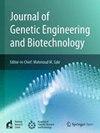揭示钩虫苯并咪唑抗性机制:分子对接和动力学研究
IF 2.8
Q3 Biochemistry, Genetics and Molecular Biology
Journal of Genetic Engineering and Biotechnology
Pub Date : 2025-02-17
DOI:10.1016/j.jgeb.2025.100472
引用次数: 0
摘要
背景:对苯并咪唑的耐药性是寄生虫面临的新挑战。它是由蠕虫β-微管蛋白基因特定位点的单核苷酸多态性(snp)引起的。实地研究和实验室调查报告了钩虫在4个密码子位点的7个等位基因变异中与抗性相关的snp。本研究旨在确定这些突变对四种钩虫对四种苯并咪唑类药物β-微管蛋白结合效率和行为的影响。方法检索犬钩虫、十二指肠钩虫、球球钩虫和美洲钩虫的β-微管蛋白基因编码序列,进行系统发育评价,并构建蛋白质的三维结构模型。对模型蛋白结构进行验证和编辑,以包含报道的snp: Q134H, F167Y, E198A, E198K, E198V, F200L和F200Y。以苯并咪唑类药物阿苯达唑(ABZ)、芬苯达唑(FBZ)、甲苯达唑(MBZ)和奥芬达唑(OBZ)作为配体。对野生型和突变蛋白进行分子对接实验。分子动力学模拟评价了β-微管蛋白-苯并咪唑配合物的动力学行为。结果硅对接分析表明,由于抗性相关snp引起的各种氨基酸取代导致了结合亲和力和位置的改变。钩虫β-微管蛋白中的E198K和Q134H显著削弱了苯并咪唑类药物的结合亲和力,改变了它们的结合位置。分子动力学分析表明,由于与苯并咪唑配体的氢键接触减少,这些突变还引起结合自由能的显著降低。结论198和134位点突变不利于钩虫产生苯并咪唑抗性。这些突变的存在可能会改变药物干预的效果。因此,应开展进一步的研究,以评估它们在有化疗史的流行地区钩虫中的出现情况。本文章由计算机程序翻译,如有差异,请以英文原文为准。

Unraveling the mechanisms of benzimidazole resistance in hookworms: A molecular docking and dynamics study
Background
Benzimidazole resistance is an emerging challenge among parasitic helminths. It is caused by single nucleotide polymorphisms (SNPs) in specific loci in helminths’ β-tubulin genes. Field studies and laboratory investigations reported resistance-associated SNPs in 4 codon locations with 7 allelic variations among hookworms. This study aimed to determine the effects of these mutations on the binding efficiency and behavior of the β-tubulin protein in four hookworm species against four benzimidazole drugs.
Methods
β-tubulin gene coding sequences of Ancylostoma caninum, A. duodenale, A. ceylanicum, and Necator americanus were retrieved, assessed phylogenetically, and used to construct the 3D structure models of the proteins. The modeled protein structures were verified and edited to contain the reported SNPs: Q134H, F167Y, E198A, E198K, E198V, F200L, and F200Y. Benzimidazole drugs such as albendazole (ABZ), fenbendazole (FBZ), mebendazole (MBZ) and oxfendazole (OBZ) were used as ligands. Molecular docking experiments were performed with the wild-type and mutated proteins. Molecular dynamics simulation assessed the dynamic behavior of the β-tubulin-benzimidazole complex.
Results
In silico docking assessments showed that various amino acid substitutions due to resistance-associated SNPs cause alterations in binding affinities and positions. E198K and Q134H in hookworm β-tubulins substantially weakened the binding affinities and altered the binding positions of benzimidazole drugs. Molecular dynamics analysis revealed that these mutations also caused marked reductions in the binding free energies owing to diminished hydrogen bond contacts with the benzimidazole ligands.
Conclusion
The evidence shown herein indicates that mutations at positions 198 and 134 are detrimental to conferring benzimidazole resistance among hookworms. The presence of these mutations may alter the efficacy of pharmacological interventions. Hence, further studies should be conducted to assess their emergence among hookworms in endemic areas with histories of chemotherapy.
求助全文
通过发布文献求助,成功后即可免费获取论文全文。
去求助
来源期刊

Journal of Genetic Engineering and Biotechnology
Biochemistry, Genetics and Molecular Biology-Biotechnology
CiteScore
5.70
自引率
5.70%
发文量
159
审稿时长
16 weeks
期刊介绍:
Journal of genetic engineering and biotechnology is devoted to rapid publication of full-length research papers that leads to significant contribution in advancing knowledge in genetic engineering and biotechnology and provide novel perspectives in this research area. JGEB includes all major themes related to genetic engineering and recombinant DNA. The area of interest of JGEB includes but not restricted to: •Plant genetics •Animal genetics •Bacterial enzymes •Agricultural Biotechnology, •Biochemistry, •Biophysics, •Bioinformatics, •Environmental Biotechnology, •Industrial Biotechnology, •Microbial biotechnology, •Medical Biotechnology, •Bioenergy, Biosafety, •Biosecurity, •Bioethics, •GMOS, •Genomic, •Proteomic JGEB accepts
 求助内容:
求助内容: 应助结果提醒方式:
应助结果提醒方式:


